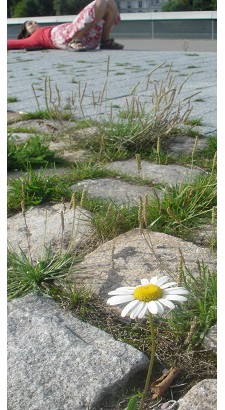Acceptaflore programme : Acceptance of spontaneous flora in the city

Project details
- Lead : Plante & Cité
- Partners : ENSP Marseille, University of Provence, FREDON Poitou-Charentes, The French Association for Food and the Environment (Maison de la Consommation et de l'Environnement), Hokus Pokus
- Funding : Écophyto (Onema)
- Duration : 2009-2011, project completed
- Plante & Cité correspondent : Damien Provendier
- Themes : Integrated pest and weed management / Economy and management / Ecology and biodiversity
- Sub-themes : Conservation and management of biodiversity, Biodiversity surveys and monitoring, Communication and public awareness, Knowledge and management of spontaneous flora
- Key words: social acceptance - communication – self-propagating flora - spontaneous flora - garden - weeds - perception
Objectives
To investigate the public’s perception of spontaneous flora in order to raise community awareness on this issue.
Abstract
The decline and withdrawal of chemical weed control in cities promotes the development of spontaneous vegetation. While the base of trees, alleys and pavements have been traditionally ‘cleaned’ using phytosanitory products and weed killers, the ‘zero pesticide’ approach encourages spontaneous flora to grow in the urban landscape. Weeds, wildflowers, wild grasses and spontaneous flora; all these terms reflect the reservations of the public who are unaccustomed to this type of urban vegetation, perspectives that managers and local authorities would like to change. The objectives of the Acceptaflore study are to aid these changes in practice and to support the public awareness campaigns.
To answer these questions, Plante & Cité formed a multidisciplinary research team in 2009 with specialists in sociology, urban ecology and communication. The socio-ecological component aimed to understand the different perceptions of the public, and the factors and actions that can promote an effective communication strategy. A survey was conducted on 420 people from seven cities with different contexts and climates. In situ, the people were asked about two types of surrounding environments: the microhabitats (areas smaller than a metre squared, such as base of trees, cracks in the pavement) and macrohabitats (e.g., gardens, parks, woodlands, sports fields, industrial areas, town squares). The aim of the survey was to identify spatial (biogeographic location, size of the commune, type of area) and socioeconomic factors (socio-professional category, degree, age, sex) which influence the public’s perception of spontaneous plants in the urban environment. This part of the study was supplemented by an analysis of the communication tools used by managers and forming recommendations for developing such tools.
Summary
This study on the public acceptance of urban spontaneous flora helps managers develop reduction policies for plant protection products. The results provide insights into the different public perceptions of urban spontaneous flora. The Acceptaflore programme and the communication component (accessible online at www.ecophytozna-pro.fr) offer tools required to communicate customised messages to the public, to help change the public’s perception of urban nature and weeds.
